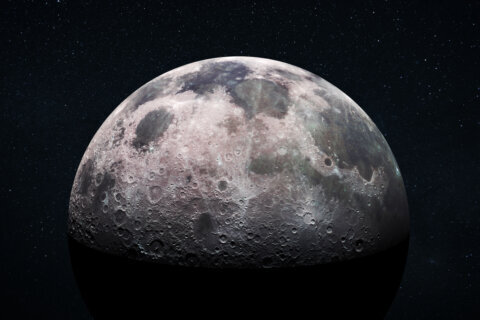Safety Note: Do not look directly at the sun or photograph it because injury to your eyes and damage to your camera will result. Sky & Telescope offers tips on how to safely and properly view the sun at its website and also offers general tips on how to safely photograph a transit, which applies to Mercury, as well as Venus.
—
WASHINGTON — With all of these clouds and rain we haven’t seen too much of the sky lately, and Monday’s forecast predicts more of the same. As seen from earth, Mercury (the planet closest to the sun) will appear to move across the face of the sun in an event that astronomers call a “transit.”
Mercury transits the sun 13 or 14 times each century. The last time this occurred was Nov. 8, 2006, and the next transit will be on Nov. 11, 2019. Hopefully, you were able to view Mercury last month.
For the D.C.-metro region, the transit starts at 7:12 a.m. EDT and lasts until 2:42 p.m. EDT, with the midpoint being at 10:57 a.m. EDT. Mercury is so small that you cannot see it with your eyes and need a properly filtered telescope to see it. Details of the event are provided at NASA’s website and at Sky & Telescope.
(Video credit: NASA)
We have several transit events taking place in our area:
- NASA will have coverage of the transit, and there will also be an hour-long program broadcast and images posted.
- National Air & Space is holding a viewing event.
- University of Maryland Observatory will have telescopes available.
- David M. Brown Planetarium, Arlington is also hosting an event.
- Montgomery College will have telescopes available.
The safest and easiest view of Mercury’s slow movement across the face of our enormous star will be by watching live on the Internet. There are several venues for you to choose from:
- Slooh.com will be hosting a live viewing event as will the National Air and Space Observatory.
- Sky & Telescope will have a live-stream event.
- You can learn more about the planet Mercury here. NASA’s MESSENGER mission, which involved our very own Johns Hopkins Applied Physics Laboratory, rewrote the textbooks on Mercury.
Be sure to see this month’s night sky sights when the clouds clear.
When it is dark, you will see bright Jupiter high in the southeast sky all month. The four main moons of Jupiter can be seen in binoculars and mimics the view Galileo would have had in his crude telescope in 1610 when he discovered them. NASA’s Juno spacecraft is closing in on the king of the planets and is due to arrive July 4.
If you are up late — around 11 p.m. — the Red Planet Mars and Saturn await your gaze. Mars will be closest to our planet on May 30, and it looks stunning as a reddish-colored “star” in the southeast sky. Do not confuse Mars with the reddish-colored star Antares, which is almost directly below it: Mars will be much brighter. The Greek name Antares means “rival of Mars,” and this month you can really see why the star got its name.
Mars has several active and planned missions exploring it from orbit and on the surface. It is a fascinating world and, in amateur-sized telescopes, actual features can be seen for the next several months. I hope to get some pictures to share with you.
Saturn is a yellowish-colored “star” to the lower left of Mars. NASA’s Cassini mission has been studying the ringed planet for 11 years and is still going strong.
Mars, Saturn and Antares make a beautiful triangle in the sky this month. If you have a dark sky you can see the gorgeous Milky Way to their lower left. The view will be best around 2 a.m. in the south over the next week before the moon starts to light up the sky.
There is much to enjoy in the sky this month. I hope you can join me at Shenandoah National Park, Peaks of Otter Lodge or Capon Springs and Farms for one of my lectures and sky viewing sessions.
Follow my daily blog at WhatsUpTheSpacePlace.com to keep up with the latest news in astronomy and space exploration. You can also email me at skyguyinva@gmail.com.







